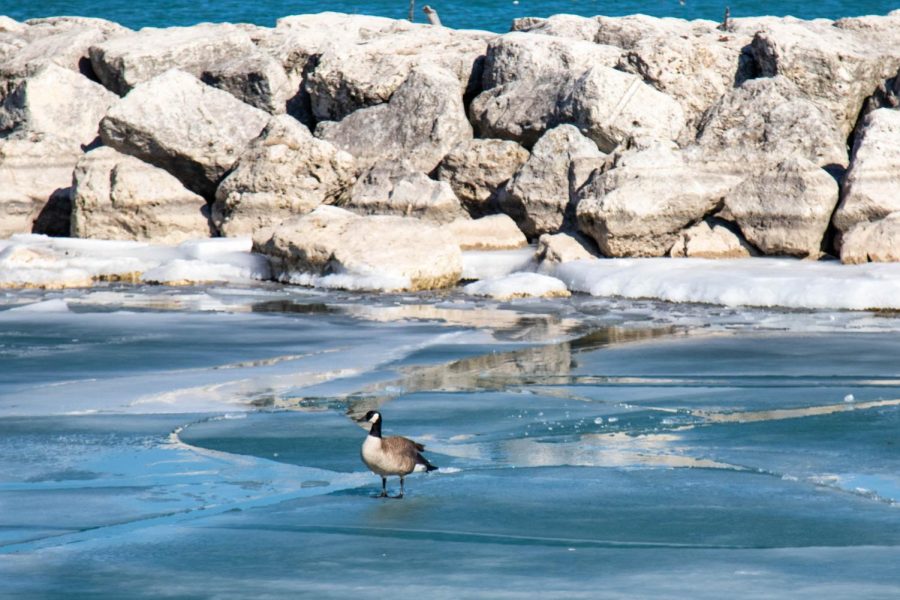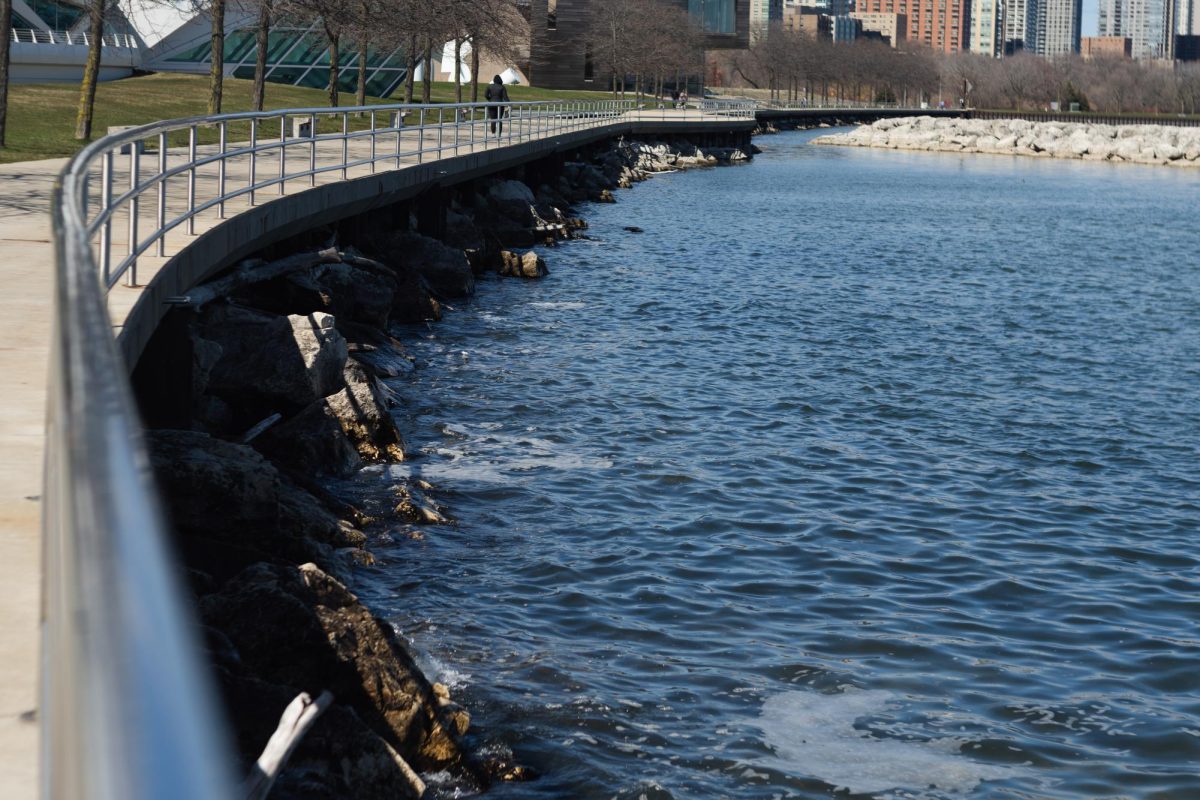As Julia Wilson, assistant coach for the Marquette Rowing team, leads her team from the Milwaukee to the Menominee Rivers, she finds that her view of bright bridges, tall buildings and clearer waters slowly turn into more industrial, murky and polluted areas.
The Milwaukee waterways include the Milwaukee, Menominee and Kinnickinnic Rivers. Being a former rowing student-athlete at Marquette who graduated in 2021, Wilson has had her fair share of contact with the Milwaukee waterways.
“(The river water) can be kinda gross,” Wilson says. “The main thing is that you should shower immediately – like immediately – and you should make sure that if you have any cuts or scratches that you rinse those out with alcohol. I don’t think that’s just a Milwaukee River thing, I think that’s just a body of water thing.”
She adds that she’s gotten pink eye four or five times from getting the water in her eyes.
“When I was in college there was a running sort of joke that rowing on the Milwaukee River if you went in you had to get a tetanus shot because it was so dirty,” Jacob Schilling, head coach of Marquette Rowing, says.
But the general cleanliness of the river impacts more than just rowers’ peace of mind.
Komatsu oil spill and other accidents
In December 2021, Komatsu spilled 400 gallons of oil into the Menomonee River – the result of an oil transfer error.
“We sincerely regret that this incident occurred and we are committed to supporting the immediate and longer-term needs of correcting the matter,” says Komatsu in an official media statement released Dec. 13.
John Koetz, Komatsu’s president of surface mining, estimated in early January that between 90% and 95% of the visible oil sheen had been cleaned.
Cheryl Nenn, an advocate at Milwaukee Riverkeeper, says the jury is still out on what the long term impacts are going to be. Milwaukee Riverkeeper is a science-based advocacy organization that works towards cleaner, healthier waters throughout the Milwaukee River Basin.
Since the spill, Milwaukee Riverkeeper has put out some devices to test invertebrates and critters at the bottom of the river to see any effects of the pollution on these marine animals, although research is still being done.
“This was a very significant oil spill. It was over 400 gallons of product that leaked into our waterways,” Nenn says.
Nenn says Milwaukee Riverkeeper and many other organizations did not find out about the oil spill until days after the incident, although Komatsu did notify the correct federal and state authorities.
“We were frustrated with the lack of good notification,” she says. “The fact of the matter is we still don’t know exactly what was discharged … we are still looking for a lot of details.”
She suggests that the communication to the public could have helped to minimize the effects of the oil spill, and could improve response times in the future.
“The good news, if there was any, is that it happened when the water was really cold and so that is helpful as far as minimizing impacts to the oxygen levels in the river that a lot of aquatic life need to survive,” Nenn says.
However, contamination in Milwaukee’s water system is nothing new.
The story of sewage
The historical layout of business around the river and the effects of industrial activity deeply affect water quality today.
Anthony Parolari, assistant professor in civil construction and environmental engineering at Marquette, states that there is lasting contamination from industrial activities, especially near the row house on the Milwaukee River. In the past, tanneries and other industrial activities produced metals and organic contaminants like polychlorinated biphenyls (PCBs), that at the time weren’t known to be harmful. These contaminants accumulated in the river, particularly in the sediments at the bottom of the river.
“As scientists studied the problem more … we started to learn that [contaminants] are bad for people and if you swim in the river or drink the water they can impact your health,” Parolari says.
As a hydrologist, Parolari studies the movement, stream flow, and quantities of the water. Experts have found that bacteria found in sewage can cause stomach and gastrointestinal illnesses. Industrial pollutants, such as metals and PCBs, can be associated with cancers, delay development in kids, kidney and liver problems and more.
But Milwaukee is not the only city with that type of contamination. The ten most endangered rivers of 2021 cites pollution as the most common issue amongst their list.
“These sort of industrial legacy pollutants are being addressed in a number of places across our country now,” Parolari says. “It’s been a very long and expensive process, but people are making efforts to improve rivers and water quality.”
He says that Milwaukee has worked to solve this problem by building a deep tunnel that stores all that sewage, and now almost all wastewater produced in the city is being treated.
Parolari says since this “deep tunnel” system was put in place in 1993, Milwaukee has reduced about 97% of the total volume of combined sewage overflow.
“As long as a community we recognize these issues are there and we recognize it’s important to have scientists and engineers working on them and there’s money available to improve the system, then yeah I have lots of hope that things will get better and we’ll be able to protect the rivers,” Parolari says.
Impact of weather
Beyond contaminants, members who use the rivers are also affected by a number of other factors. Severe weather is a big factor.
For the Marquette rowing team, lightning storms, high wind level and frigid temperatures all affect their ability to get on the water. The current can also pose a challenge.
“In the last three years actually with the heavy rains in the fall, we’ve actually been held off the water on perfectly clear sunny days because the current is actually too high for us to row safely,” Schilling says.
Indoor practice is often the result, but this comes as a loss to rowers.
“The biggest disadvantage [of practicing inside] is you lose what we call ‘boat feel,'” Schilling says. “And that is literally feeling what the boat is doing and how its moving underneath you. The machines can’t replicate all of it.”
There is a community built around the waterways of Milwaukee. Actions of restoration and attention to climate changes is what will allow these rivers to continue serving the community.
“I’ve been drawn to the water, and I love being outdoors and I love working hard with my teammates,” James Kuchera, a junior of the Opus College of Engineering and rowing team members, says. “Our water time is what really brings us together, gets us off campus, and gets us outside in the morning … We are definitely really privileged to have access to our water here. And really, I always have my eyes out and hoping for spring to come a little sooner.”




